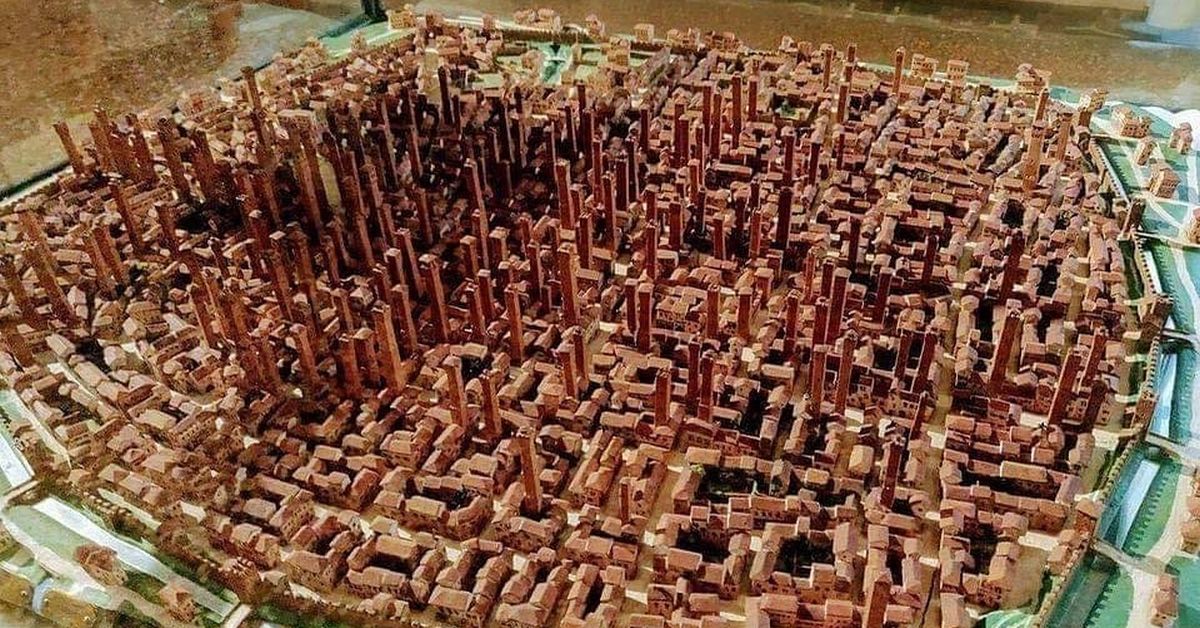Manhattan of the Middle Ages: in AD 1200 the Italian city of Bologna had about 180 towers – today, we would call them skyscrapers. The tallest of them at 320 (97 meters) feet high is still standing today!

Between the 12th and the 13th century, Bologna was a city full of towers, looking much like Manhattan today. Some of those towers were quite tall, too, the highest being 97m. And they were definitely built for defense.
Besides the towers, there are still some fortified gateways (torresotti) that correspond to the gates of the 12th-century city wall (Mura dei torresotti or Cerchia dei Mille), which itself has been almost completely destroyed.
But even if for defense, what justifies the presence of so many towers of extreme height built during that period of Bologna’s history?
The short answer is we don’t know. One hypothesis is that the richest families used them for offensive/defensive purposes during the period of the Investiture Controversy – a conflict between the church and the state in medieval Europe over the ability to choose and install bishops (investiture) and abbots of monasteries and the pope himself.

In the 13th century, many towers were taken down or demolished, and others simply collapsed. Many towers have subsequently been utilized in one way or the other: as prison, city tower, shop or residential building. Still, the towers remained a famous sight of Bologna throughout the later periods; even Dante mentioned some of the towers in his Inferno. The last demolitions took place during the 20th century, due to an ambitious, but retrospectively unfortunate, restructuring plan for the city; the Artenisi Tower and the Riccadonna Tower at the Mercato di mezzo were demolished in 1917.

Today, fewer than twenty towers can still be seen in Bologna. These include the Azzoguidi Tower, also called Altabella (with a height of 61 m), the Prendiparte Tower, called Coronata (60 m), the Scappi Tower (39 m), Uguzzoni Tower (32 m), Guidozagni Tower, Galluzzi Tower, and the famous ‘Two Towers’: the Asinelli Tower (97 m) and the Garisenda Tower (48 m).


The construction of the towers was quite a big effort, requiring the work of a high number of serfs, or peasants. Building the typical Bologna tower of 60 m height probably required between three and ten years of work.
All towers built in this rather interesting, yet little known, period had a square cross-section with foundations between five and ten meters deep, reinforced by poles hammered into the ground and covered with pebble and lime. Large blocks of selenite stone were used to build the tower’s base, while the remaining walls were successively thinner and lighter.
The higher the structure was raised, the more it was implemented through so-called “a sacco” masonry: with a thick inner wall and a thinner outer wall, and the gap between them being filled with stones and mortar.
Most of the time the builders left some holes in the outer wall as well as bigger hollows in the selenite to support scaffoldings and to allow for later coverings and constructions.

Apparently these towers crowded Bologna in the Middle Ages, and so the city must have been a really peculiar sight in those days.
The first historian to study the skyscrapers of Bologna in a systematic way was Count Giovanni Gozzadini, a senator of the Italian kingdom who lived in the 19th century and wanted to raise the prestige of his home town in the context of the now united Italy. Analyzing the civic archives of real estate deeds, Gozzadini attempted to arrive at a reliable number of towers on the basis of documented ownership changes. He eventually came up with the extraordinary number of 180 towers, an enormous amount considering the size and resources of medieval Bologna.

Those towers definitely hold a secret.
Sources: 1, 2, 3
